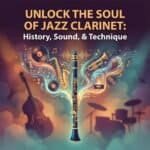The clarinet in jazz festivals traces a clear arc: from early jazz and swing stars in the 1920s like Benny Goodman and Artie Shaw, through bebop innovators such as Buddy DeFranco, to modern festival mainstays including Anat Cohen and Evan Ziporyn. At events like the New Orleans Jazz & Heritage Festival and Monterey Jazz Festival, the clarinet now balances tradition, adventurous improvisation, and cross-genre collaborations.
The Clarinet's Early Roots in Jazz
Clarinet entered jazz before large festivals existed, in the 1910s and early 1920s, when New Orleans and Chicago dance bands shaped the new style. Players such as Sidney Bechet and Johnny Dodds used the clarinet's flexible range to weave countermelodies around cornet and trombone lines, setting the template for later festival ensemble roles.
In Storyville and early Chicago clubs, clarinet often acted as the agile top voice. Its bright upper register cut through noisy rooms, while the chalumeau register added warmth. These acoustic realities later mattered at outdoor festivals, where projection and clarity remained important for unamplified or lightly amplified performances.
By the early 1920s, clarinet appeared on over 40 percent of documented New Orleans-style jazz recordings, reflecting its central role in the emerging ensemble sound.
Although formal jazz festivals did not yet exist, proto-festival events such as riverboat excursions, regional fairs, and traveling revues already featured clarinetists. These itinerant performances foreshadowed modern touring logistics: long travel days, quick setups, and the need for reliable instruments that could survive changing climates.
As jazz spread to New York and Europe, clarinetists carried regional styles with them. Early recordings by Louis Armstrong's Hot Five and Hot Seven, plus Clarence Williams groups, became reference points for later festival revival programming, especially at events focused on traditional jazz and early swing.
The Roaring Twenties: Clarinet Takes Center Stage
During the 1920s and 1930s, the clarinet shifted from ensemble color to featured solo voice. Benny Goodman, Artie Shaw, and Jimmy Dorsey turned the instrument into a star attraction, a trend that festival programmers would later celebrate through tribute sets and big band recreations on large stages worldwide.
The rise of big band swing coincided with the earliest large-scale jazz gatherings. While not branded as festivals in the modern sense, events like Carnegie Hall concerts and ballroom marathons functioned similarly. Clarinet-led bands drew huge audiences, proving that the instrument could carry a full evening program and headline major events.
Goodman's 1938 Carnegie Hall concert, often cited as a turning point for jazz respectability, became a template for later festival programming. Multi-set formats, guest soloists, and historical medleys all reappear in modern festival schedules, where clarinetists often anchor “From Swing to Bop” or “Great American Songbook” themed shows.
Artie Shaw pushed repertoire boundaries with classical influences and lush orchestrations. His approach foreshadowed cross-genre festival programming that now includes chamber-jazz sets, symphonic collaborations, and clarinet features with strings. For clarinetists, this era proves that strong melodic conception can command even the largest festival stages.
By the late 1930s, clarinet had achieved full mainstream visibility. Radio broadcasts, touring dance bands, and early outdoor concerts helped solidify the instrument's image as both virtuosic and accessible. Modern festival audiences still respond to this legacy when they hear familiar swing standards and recognizable clarinet timbres.
Bebop and Beyond: Mid-Century Transformations
The bebop era of the 1940s and 1950s shifted attention to saxophone and trumpet, but clarinet did not disappear. Instead, players like Buddy DeFranco translated bebop language to the instrument, influencing later festival programming that highlights virtuosic small-group improvisation and modern harmonic concepts.
DeFranco's work with big bands and small ensembles showed that clarinet could handle rapid chord changes and complex lines. His recordings became a resource for festival clinicians and masterclass leaders, who now use his solos to teach articulation, phrasing, and advanced harmonic thinking to aspiring clarinetists.
At the same time, the traditional jazz revival of the 1950s and 1960s brought clarinet back into public view. Festivals in places like New Orleans and Sacramento began featuring trad bands with prominent clarinet parts, often modeled on earlier New Orleans styles but presented on modern outdoor stages with microphones and sound systems.
The founding of the Newport Jazz Festival in 1954 and the Monterey Jazz Festival in 1958 created new platforms for clarinetists. Sets by artists such as Jimmy Giuffre and later Eric Dolphy introduced festival audiences to cool jazz, chamber jazz, and avant-garde approaches that used clarinet and bass clarinet in exploratory ways.
By the late 1960s, at least 3 major North American jazz festivals regularly programmed clarinet or bass clarinet features each year, according to surviving festival programs and press coverage.
From the 1970s through the 1990s, clarinet found fresh roles in fusion, world music, and experimental projects. Bass clarinet became a staple in the work of artists like Bennie Maupin, whose festival appearances with Herbie Hancock and others demonstrated the instrument's deep, atmospheric potential in amplified outdoor settings.
Clarinet Variants and Instrument Anatomy in Jazz
Festival performance rewards clarinetists who understand their instrument's anatomy and how different variants behave on large stages. The most common jazz choice is the B-flat clarinet, but A clarinet and bass clarinet also appear in festival sets, especially in chamber-jazz and modern large ensemble contexts.
A standard B-flat clarinet consists of five main parts: mouthpiece, barrel, upper joint, lower joint, and bell. The reed sits on the mouthpiece table, held by a ligature. Keywork spans the upper and lower joints, where tone holes and pads control pitch. Each component affects projection, tuning stability, and tonal color in festival environments.
Bore design matters outdoors. A more open bore and medium-facing mouthpiece can help projection when playing without heavy amplification. Many jazz players choose mouthpieces with slightly larger tip openings and medium-strength reeds, such as 2.5 or 3, to balance flexibility and control during long festival sets.
Bass clarinet adds a different dimension. Its longer body and larger bore produce a darker, more resonant sound that fills outdoor spaces effectively when properly miked. Extended keywork down to low C or low E-flat allows festival arrangers to write bass lines, counterlines, and textural effects that stand out in modern ensembles.
On mixed-genre festival bills, clarinetists report using B-flat clarinet on roughly 70 percent of tunes, bass clarinet on 20 percent, and other variants such as E-flat or contrabass clarinet on the remaining 10 percent.
Mouthpiece and ligature choices also influence festival success. Hard rubber mouthpieces often provide a warm yet focused sound that records well and blends with brass and saxophones. Metal ligatures can add brightness and quick response, useful when switching between straight-ahead swing, Latin grooves, and contemporary textures in a single festival set.
Maintenance and Touring: Festival-Ready Care for the Clarinet
Multi-day festivals and touring schedules demand a clear maintenance plan. Clarinetists face long travel days, quick changeovers, and varying temperature and humidity. A structured checklist helps keep the instrument stable so players can focus on musical communication rather than emergency repairs between sets.
Daily care starts with thorough swabbing after each set. Pull a soft swab through the upper and lower joints separately to remove moisture that can swell pads and encourage mold. Wipe the tenons gently, then apply a small amount of cork grease to maintain smooth assembly without over-lubrication.
Pad care is important during festivals. Before the first set each day, inspect key pads for moisture or discoloration. Use cigarette paper or pad paper under sticky pads, closing the key gently to absorb residue. Avoid pressing hard, which can deform the pad. This simple routine can prevent mid-set sticking that disrupts solos.
Reed management deserves special attention. Rotate at least 4 to 6 reeds in a ventilated reed case. Label them by date and strength. For outdoor festivals, consider slightly stronger reeds to handle warmer, more humid conditions that can soften cane. Test each reed briefly before going on stage to confirm response and pitch stability.
Humidity control starts with the case. Use small case humidifiers or silica gel packs, adjusting based on climate. In very dry conditions, a case humidifier helps prevent cracking in wooden clarinets. In very humid regions, desiccant packs reduce swelling. Monitor conditions daily during long festivals where weather can change quickly.
Pack a compact tool kit: small screwdriver set, pad paper, cork grease, pull-through swab, mouthpiece brush, spare ligature, and at least one backup mouthpiece. Include spare barrels of slightly different lengths to adjust tuning for extreme temperature shifts on outdoor stages.
Before a major festival, schedule a full checkup with a qualified technician. Ask for a leak test, pad inspection, regulation of key heights, and spring tension adjustments. Plan this at least two weeks before departure so you have time to adapt to any changes in feel or response.
Troubleshooting Common Performance Issues at Festivals
Festival conditions often magnify small problems. Heat, dust, quick changeovers, and stage noise can all contribute to squeaks, leaks, and tuning issues. A practical troubleshooting routine helps clarinetists stay calm and fix problems quickly between tunes or even mid-phrase when necessary.
Squeaks usually come from reed and embouchure issues. If squeaks increase suddenly, check that the reed is centered on the mouthpiece with equal overhang on both sides. Ensure the ligature is snug but not crushing the reed. If the tip is chipped or waterlogged, switch to a fresh reed immediately.
Air leaks often show up as unstable low notes or fuzzy attacks. Gently press around suspect tone holes while playing long tones to locate leaks. If a pad is not sealing, use pad paper to clean it and the tone hole. If the leak persists, mark the key mentally and avoid exposed low-register passages until a technician can adjust it.
Sticky pads are common in humid outdoor festivals. Before each set, lightly treat problem pads with pad paper. During the set, if a key sticks, discreetly open and close it several times between phrases. Some players keep a small piece of cigarette paper in a pocket to address sudden sticking during long solos.
Intonation drift often follows temperature changes. In hot conditions, the clarinet tends to go sharp. Pull the barrel out slightly and relax the embouchure. In cold conditions, push the barrel in and support the air more firmly. Use reference pitches from piano, bass, or tuning apps before each set, especially on large festival stages.
Mouthpiece or reed slippage can occur during energetic performances. Make a habit of checking ligature screws and reed alignment during applause or while bandmates are soloing. A quick adjustment can prevent a catastrophic squeak in the next chorus.
Know when to call a technician. Persistent leaks, bent keys from travel accidents, or cracked joints require professional repair. During multi-day festivals, ask organizers for local repair contacts in advance. Arrive with clear notes about symptoms and, if possible, short recordings that demonstrate the problem.
Key Jazz Festivals That Highlight the Clarinet (archival highlights)
Several major festivals have played important roles in showcasing clarinet. The New Orleans Jazz & Heritage Festival, Monterey Jazz Festival, and Newport Jazz Festival all maintain archives that document clarinet performances, set lists, and evolving programming trends from the mid-20th century to the present.
New Orleans Jazz & Heritage Festival frequently features traditional jazz ensembles with clarinet in the front line. Archival programs from the 1970s onward show recurring appearances by local clarinetists in brass bands, small trad groups, and cross-cultural projects that blend New Orleans styles with Caribbean and African influences.
Monterey Jazz Festival has a long history of innovative clarinet programming. From Jimmy Giuffre's cool jazz explorations to more recent performances by Anat Cohen, the festival has treated clarinet as both a historical and contemporary voice. Monterey's recorded sets provide valuable case studies in microphone placement, repertoire choices, and ensemble balance.
Newport Jazz Festival archives reveal clarinet in many contexts: swing revival projects, bebop retrospectives, and avant-garde experiments. Bass clarinet features by artists in the 1960s and 1970s helped legitimize the instrument as a solo voice, not just a color in large ensembles. These recordings remain important listening for programmers and performers.
European festivals such as North Sea Jazz Festival and Montreux Jazz Festival have also highlighted clarinet, often in cross-genre collaborations. Programs from the 1980s and 1990s show clarinetists appearing with world music ensembles, contemporary classical groups, and electronic projects, reflecting broader trends in festival curation.
From the Martin Freres perspective, early 20th-century festival-like gatherings in France and Belgium sometimes featured clarinet choirs and mixed ensembles that included Martin Freres instruments. Surviving posters and programs in private collections show how European makers and players contributed to the clarinet's visibility in pre- and post-war open-air concerts.
Regional festivals, including Sacramento Music Festival and smaller traditional jazz events, maintain strong clarinet traditions. Their archives often include handwritten set lists, band photos, and local newspaper reviews that document how clarinet repertoire and audience expectations have shifted over decades.
Contemporary Clarinet Voices and Notable Festival Performances
Today, clarinet in jazz festivals is defined by versatility. Artists such as Anat Cohen and Evan Ziporyn move easily between straight-ahead jazz, Brazilian choro, contemporary classical, and experimental music. Their festival appearances illustrate how clarinet can serve as a bridge between genres and generations.
Anat Cohen has become a fixture at major festivals including Newport, Monterey, and North Sea. Her sets often mix swing standards, original compositions, and Brazilian pieces, demonstrating a flexible approach to programming. She highlights the clarinet's singing upper register and expressive pitch bends, which translate well to large outdoor audiences.
Evan Ziporyn brings clarinet and bass clarinet into contemporary classical and world music contexts. Festival performances with ensembles such as Bang on a Can and various Balinese gamelan collaborations show how clarinet can integrate into non-traditional rhythm sections and textures, expanding what festival audiences expect from the instrument.
Other contemporary voices include Don Byron, Ken Peplowski, and Paquito D'Rivera, each with distinctive festival profiles. Byron's genre-bending sets, Peplowski's swing-rooted but harmonically adventurous playing, and D'Rivera's Latin jazz and classical crossover work all provide models for clarinetists designing festival programs.
Many modern clarinetists also lead workshops and clinics at festivals. These sessions cover improvisation, doubling on saxophone or flute, and practical topics like reed selection for outdoor stages. For aspiring professionals, clinic invitations often follow strong main-stage performances and can become important income and networking opportunities.
Streaming and video archives now preserve many of these performances. Festival channels on platforms such as YouTube and dedicated streaming services allow clarinetists and programmers to study camera angles, microphone placement, and audience reactions to specific tunes and arrangements.
Programming, Repertoire, and Arranging for Festival Stages
Effective festival programming for clarinet balances history, variety, and practical staging. Programmers and bandleaders must consider time limits, stage turnover, and audience diversity. A well-structured set often includes a mix of swing, ballads, world-influenced pieces, and original compositions that highlight different registers and articulations.
For traditional or swing-focused sets, repertoire might include pieces associated with Benny Goodman or Artie Shaw, arranged with updated harmonies or rhythmic feels. Clarinet can take the main melody, with saxophones and brass providing riffs and backgrounds. Short, well-planned shout choruses keep energy high on large outdoor stages.
Modern small-group sets can feature original tunes with clear melodic hooks and space for improvisation. Clarinetists often exploit the instrument's ability to move quickly between registers, writing themes that leap from chalumeau to clarion. Arrangers can use bass clarinet for pedal points, ostinatos, and call-and-response with drums or bass.
Cross-genre programming might pair clarinet with strings, accordion, or world percussion. At festivals that mix jazz with folk and global music, clarinetists can draw on klezmer, choro, or Balkan influences. Clear charts, flexible forms, and strong rhythmic grooves help unfamiliar audiences connect quickly.
Outdoor stages require attention to pacing. Up-tempo numbers work well early in the set to capture attention, followed by a ballad or duo feature that brings dynamics down. Mid-set, a bass clarinet feature or unaccompanied intro can create a memorable moment. Closing with a familiar standard or catchy original leaves a strong impression.
Arrangers should consider amplification from the start. Write parts that avoid extreme soft dynamics if the sound system is basic. Allow space for solos so the front-of-house engineer can adjust levels. When possible, coordinate with sound staff about clarinet mics, monitors, and any doubling on saxophone or flute.
Cultural Impact, Audience Reception, and Player Outcomes
The clarinet's presence at jazz festivals carries cultural weight. It connects audiences to early jazz history while signaling openness to innovation. Listeners often associate clarinet with both nostalgia and freshness, especially when artists blend traditional vocabulary with contemporary rhythms and harmonies.
Audience reception tends to be strong when clarinetists communicate visually and verbally. Brief introductions that explain a tune's background or dedicate a piece to a historical figure help listeners follow the narrative. The instrument's vocal quality makes it easy for non-musicians to latch onto melodies, even in complex harmonic settings.
For players, festival visibility can shape careers. High-profile sets often lead to invitations for collaborations, recording projects, and teaching positions. Clarinetists who appear regularly at major festivals may develop parallel careers as educators, clinicians, and ensemble leaders, expanding their influence beyond a single instrument role.
Cross-genre collaborations at festivals can open unexpected paths. A clarinetist who sits in with a world music group or experimental ensemble may later receive commissions, residency offers, or film scoring work. These outcomes show how festival stages function as laboratories for new combinations of sound and career directions.
Metrics such as number of festival appearances per year, recorded live albums, and leadership roles in ensembles help clarify career trajectories. Some artists build reputations as festival specialists, known for crafting sets that travel well, adapt to different lineups, and engage diverse audiences.
For students and emerging professionals, attending festivals as listeners or volunteers can be just as important as performing. Observing how established clarinetists structure sets, handle sound checks, and interact with audiences provides practical models that are difficult to gain from recordings alone.
Archival Sources, Data Points, and Further Reading
Reliable archival sources help clarify the clarinet's evolving role in jazz festivals. Many major festivals maintain online archives of programs, artist lists, and selected recordings. These resources allow researchers, programmers, and performers to trace repertoire choices, ensemble formats, and the frequency of clarinet features over time.
New Orleans Jazz & Heritage Festival, Monterey Jazz Festival, and Newport Jazz Festival all offer partial digital archives. These often include scanned programs, historical essays, and curated playlists. University libraries and jazz studies centers sometimes host additional collections of posters, ticket stubs, and radio broadcast recordings.
Discographies and sessionographies provide another layer of data. By cross-referencing festival dates with recorded live albums, researchers can reconstruct set lists and personnel. This helps clarinetists identify historically informed repertoire and arrangement ideas that still resonate with modern audiences.
Biographies of key clarinetists, such as Benny Goodman and Artie Shaw, contain detailed accounts of touring and festival-like engagements. More recent profiles of Buddy DeFranco, Anat Cohen, and Evan Ziporyn offer insight into contemporary touring realities, including travel logistics, doubling on multiple instruments, and collaborations across genres.
For deeper study, academic journals on jazz history and ethnomusicology often publish articles on specific festivals, regional scenes, and instrument roles. These articles can reveal socio-cultural factors, such as segregation, migration, and technology, that shaped when and how clarinet appeared on festival stages.
Private collections, including those maintained by families of instrument makers like Martin Freres and by local historical societies, sometimes hold rare programs and photographs. When accessible, these materials add nuance to the public record and highlight lesser-known clarinetists who contributed to festival culture in their regions.
Key Takeaways
- The clarinet's role in jazz festivals spans from early New Orleans and swing traditions to modern cross-genre experiments, with each era leaving distinct repertoire and ensemble models.
- Understanding clarinet anatomy, equipment choices, and maintenance routines is important for reliable performance on demanding multi-day festival schedules.
- Festival success for clarinetists depends on thoughtful programming, practical troubleshooting skills, and the ability to connect historical roots with contemporary sounds.
FAQ
What is clarinet in jazz festivals?
Clarinet in jazz festivals refers to the instrument's role as a solo and ensemble voice on multi-artist jazz events. It covers historical swing and traditional styles, modern small-group improvisation, cross-genre collaborations, and educational clinics, all presented on stages ranging from intimate tents to large outdoor arenas.
How has the clarinet's role in jazz festivals changed over time?
The clarinet moved from a leading melodic voice in early jazz and swing to a more specialized role during the bebop era, then re-emerged through traditional jazz revivals and modern innovators. Today it appears in historical tributes, contemporary ensembles, world music projects, and experimental sets across major festivals.
Which jazz festivals are best known for featuring clarinet performances?
New Orleans Jazz & Heritage Festival, Monterey Jazz Festival, and Newport Jazz Festival are especially known for clarinet features. European events like North Sea Jazz Festival and Montreux Jazz Festival also present clarinetists in diverse contexts, from traditional swing to avant-garde and cross-cultural collaborations.
What clarinet equipment and reeds work best for outdoor festival performances?
Many players prefer a B-flat clarinet with a medium-open hard rubber mouthpiece and medium-strength reeds, such as 2.5 or 3, for outdoor stages. A secure ligature, ventilated reed case, spare barrels for tuning, and a backup mouthpiece help maintain stable response and intonation in changing weather conditions.
How can a clarinetist troubleshoot squeaks and leaks during a festival set?
For squeaks, check reed alignment, ligature tightness, and reed condition, then adjust embouchure and air support. For leaks, test tone holes while playing long tones and clean suspect pads with pad paper. If problems persist, avoid exposed passages on affected notes and consult a technician as soon as possible.
Where can I find archived festival programs and recordings featuring clarinetists?
Start with the online archives of New Orleans Jazz & Heritage Festival, Monterey Jazz Festival, and Newport Jazz Festival. University jazz collections, national libraries, and streaming platforms with curated festival playlists also provide access to historical programs, recordings, and video of notable clarinet performances.






